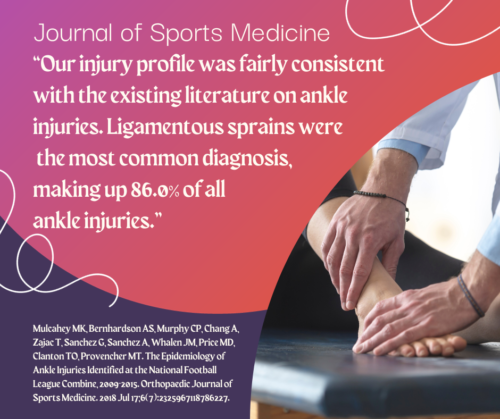
Does your ankle give out frequently? There is a reason for repeat ankle sprains. It’s a common problem for people with ankle instability! And what causes ankle instability? Very often, the source of ankle instability is ligament damage from an injury that occurred at some point in your life.
Anything that stretches the soft tissue of the ankle joint abnormally can cause an injury to the ankle ligaments. For example, overturning the ankle inwards or outwards can injure the ligaments. Ankle sprains consist of some type of ligament injury. These injuries may be mild, moderate, or severe, but all involve ligament injury and/or tears of the ankle ligaments.
When a ligament injury does not fully heal, a cycle of instability begins because the ligament(s) have now become weakened, allowing for abnormal ankle joint movement. As time progresses, other ankle structures will also begin to degenerate, resulting in eventual arthritis.
The medical journal Food & Ankle International explains it like this, “Chronic ankle instability can result from untreated or badly managed acute lateral ankle ligament injuries.” (1)
Researchers in the Journal of Sports Medicine studied ankle sprains in elite football players. They found that their “injury profile was fairly consistent with the existing literature on ankle injuries. Ligamentous sprains were the most common diagnosis, making up 86.0% of all ankle injuries.” Plus, in their research, they also found that over 50% of the players had previous ankle injuries. (2)
The British Journal of Sports Medicine concluded that an ankle injury is not always new or acute but can be identified as an old, chronic injury with increased symptoms. (3)
Frequently, what is thought of as a new ankle sprain may be an old ankle injury that went undetected or never fully healed. An unhealed ligament injury at some point in the person’s life has likely left the ankle unstable and prone to recurrent sprains.
Many common treatments do not address ligament injuries. That’s why the problem doesn’t resolve no matter what you try. And, understandably, recurrent ankle sprain sufferers would be hesitant to use them again when they didn’t work well to begin with. Fortunately, Regenerative Orthopedics are able to treat ligament injuries effectively. These treatments are known for being effective for just this kind of problem…soft tissue injuries.
So if you notice your ankle getting weaker and weaker and more unstable but feel like nothing out there works for you, then know that there is a treatment that addresses the source of the problem.
If you look up common treatments for ankle sprains, you will find rest, ice, compression, elevation, anti-inflammatory medications, and bracing or casting. Those with repeat ankle sprains have most likely tried all of these treatments.
Sure, the treatments may provide some relief, but the ankle remains unstable. That is because none of these treatments repair the injured ligaments.
Ice does not repair ligaments.
Braces, taping, and casts do not repair ligaments.
Elevation does not repair ligaments.
Anti-inflammatories do not repair ligaments.
Pain medications do not repair ligaments.
Plus, your ankle sprain is likely taking longer and longer to heal. You may even require crutches to get around. The treatment is always the same, but it isn’t working.
What can you do? What is needed is a treatment directed at ligament repair to achieve the relief you seek. Yes, treatments like physical therapy to strengthen musculature are helpful, but since muscles also depend on strong tendons and ligaments for proper function and stability, repair of these soft tissue structures will need to be addressed.
At OrthoRegen®, our treatment of choice is Regenerative Orthopedics. The great news is that these non-surgical treatments work to repair the ligaments. The treatment is not just a bandaid or a cover-up for the pain. Regenerative therapies, like Prolotherapy, PRP, and Stem Cells, have been shown to repair and regenerate the injured soft tissue structures.
Additionally, the treatment needs to be comprehensive. Chronic ankle instability has likely affected multiple ligaments or soft tissue structures. The entire area needs to be treated for the best possible outcome. By repairing the ligaments and any other involved soft tissue structures, the joint becomes strengthened, and the instability resolves. The result is decreased pain and stiffness, increased function, and an improved quality of life. (4)
PRP or Stem Cells may be recommended in addition to Prolotherapy in cases of more deterioration and degeneration. Research has shown that these treatments are also effective at repairing the ankle’s soft tissue. (5,6)
At OrthoRegen®, we have many years of experience with Regenerative therapies and would be happy to help you resolve your repeat ankle sprains and improve your ankle function. Call us today at (310)453-1234.
(1) Aicale R, Maffulli N. Chronic Lateral Ankle Instability: Topical Review. Foot & Ankle International. 2020 Dec;41(12):1571-81
(2) Mulcahey MK, Bernhardson AS, Murphy CP, Chang A, Zajac T, Sanchez G, Sanchez A, Whalen JM, Price MD, Clanton TO, Provencher MT. The Epidemiology of Ankle Injuries Identified at the National Football League Combine, 2009-2015. Orthopaedic Journal of Sports Medicine. 2018 Jul 17;6(7):2325967118786227.
(3) Shrier I, Clarsen B, Verhagen E, Gordon K, Mellette J. Improving the accuracy of sports medicine surveillance: when is a subsequent event a new injury? Br J Sports Med. 2016 Jun 28.
(4) Hauser RA, Hauser, MA, Cukla J. Dextrose Prolotherapy Injections for Chronic Ankle Pain. Practical Pain Management. January/February 2010 p 70-76.
(5) Hauser RA, Ostergaard, S. Direct bone marrow injections for avascular necrosis of the talus: a case report. Journal of Prolotherapy. 2012;4:e891-e894.
(6) Laver L, Carmont MR, McConkey MO, Palmanovich E, Yaacobi E, Mann G, Nyska M, Kots E, Mei-Dan O. Plasma rich in growth factors (PRGF) as a treatment for high ankle sprain in elite athletes: a randomized control trial. Knee Surg Sports Traumatol Arthrosc. 2015 Nov;23 (11):3383-92.